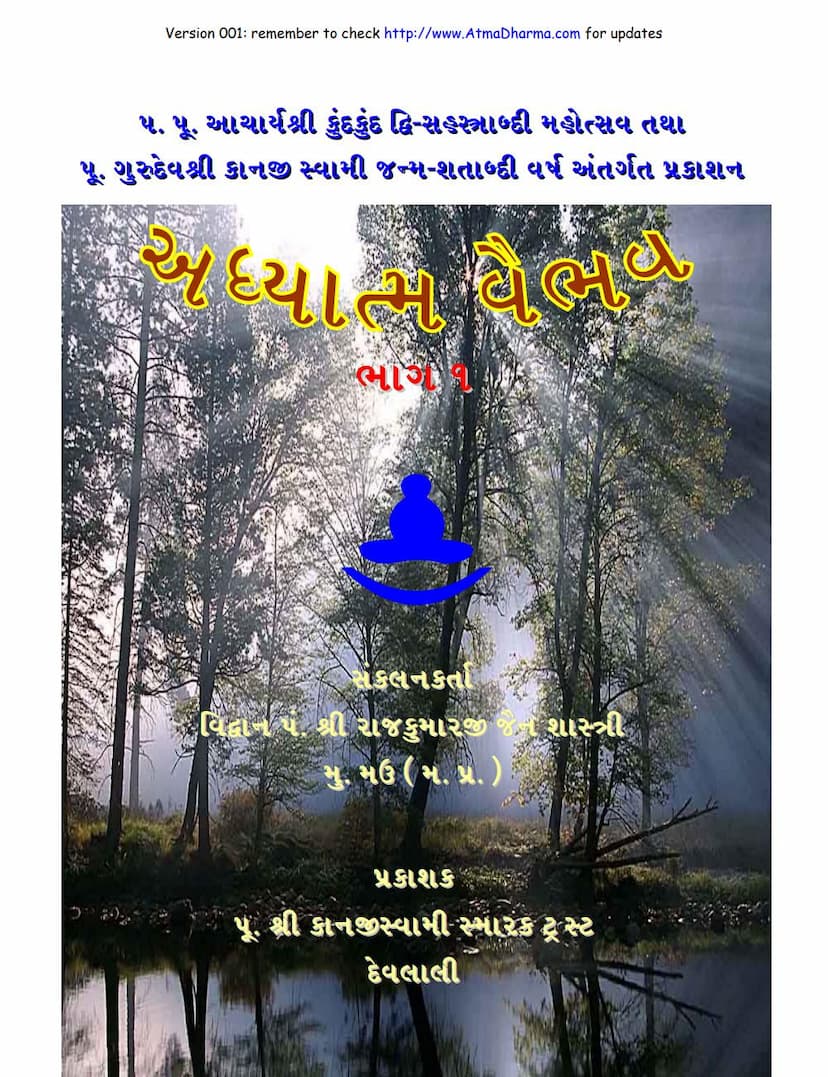Adhyatma Vaibhav1
Added to library: September 1, 2025

Summary
Certainly, here's a summary of the Jain text "Adhyatma Vaibhav," focusing on the key themes and teachings presented in the provided excerpts, particularly concerning the nature of the soul (Jiva) and the path to liberation (Moksha).
Adhyatma Vaibhav: A Summary of Jain Spiritual Teachings
The text "Adhyatma Vaibhav" (Spiritual Grandeur), compiled by Rajkumar Jain and published by the Pujya Shri Kanji Swamy Smarak Trust, serves as a profound exploration of Jain spiritual philosophy, primarily drawing from the teachings of Acharya Kundakunda and Pujya Gurudev Shri Kanji Swami. The core of the text revolves around understanding the true nature of the soul (Atma) and the path to its liberation (Moksha).
The Essence of the Soul (Atma):
The text repeatedly emphasizes that the soul is inherently pure, eternal, and self-luminous, characterized by consciousness, bliss, and omnipotence. It is described as:
- "Godly Soul" (Bhagavan Atma): The soul is not a mere mortal being but a divine entity, an eternal king or lord of bliss. It is described using numerous epithets like "Chidanandghan" (essence of consciousness and bliss), "Gyanaswarup" (embodiment of knowledge), "Anantgun swarupi" (possessing infinite virtues), and "Parmatma" (Supreme Soul).
- Eternal and Unchanging: The soul is beyond birth, death, bondage, and liberation in its essential nature. It is immutable, existing eternally in its pure consciousness and bliss.
- Self-Sufficient and Independent: The soul is inherently complete and does not depend on external factors for its existence or experience of bliss. All its virtues and powers are inherent within.
- Distinct from the Non-Soul (Ajiva): A fundamental distinction is drawn between the soul (Jiva) and all other substances (Ajiva), including the body, mind, speech, karma, and even subtle emotional states like attachment (Raga) and aversion (Dvesha). These external factors are seen as transient and non-essential to the soul's true nature.
The Path to Liberation (Moksha):
The text meticulously outlines the path to realizing the soul's true nature and achieving liberation, emphasizing the following core principles:
- Self-Realization (Atmanubhuti): The primary focus is on turning inward and experiencing the soul's true nature through self-realization. This is achieved by withdrawing the senses and intellect from external objects and immersing them in the soul's inherent consciousness and bliss.
- Discrimination (Bhed-Jnana): A crucial aspect of the path is the development of right knowledge (Samyak-Jnana), which involves discriminating between the soul and the non-soul. This involves understanding that the body, emotions like Raga (attachment), Karma, and even external objects are not the soul.
- Right Faith (Samyak-Darshan): This is the initial stage of spiritual realization, characterized by a firm conviction in the soul's true nature as pure, eternal, and blissful. It involves seeing the soul as it truly is, beyond the transient states of bondage and liberation.
- Right Conduct (Samyak-Charitra): Right conduct is not merely external rituals or austerities but the living out of the soul's true nature, which is characterized by equanimity, non-violence, truthfulness, non-possessiveness, and celibacy (in its inner spiritual sense). It is the continuous dwelling in the soul's inherent nature.
- Rejection of External Rituals: The text strongly de-emphasizes the importance of external rituals, penances, and devotional practices (like idol worship, fasting, external austerity) as the primary means to liberation. While these may have a place in preliminary stages or as external expressions, they are ultimately considered ineffective for true spiritual attainment if not accompanied by inner self-realization.
- The Primacy of Inner Experience: The ultimate goal is the direct, unmediated experience of the soul's pure consciousness and bliss. This inner experience, described as "Atmanubhuti," is the true path and the essence of liberation.
- The Impermanence of Externalities: The transient nature of the physical body, worldly possessions, emotions like Raga, and even the stages of spiritual practice (like different levels of knowledge) are highlighted. The ultimate reality is the eternal, unchanging soul.
- The Role of Gurudev Shri Kanji Swami: The text reflects the deep reverence for Gurudev Shri Kanji Swami, whose teachings are presented as the guiding light, illuminating the path to self-realization and spiritual grandeur. His emphasis on the soul's inherent divinity and the direct path of self-experience is central.
Key Concepts Highlighted:
- "Svasambodhana" (Self-Introspection): The practice of looking inward and realizing the soul's true nature.
- "Nirvikalpa Samadhi" (Thought-free State): A state of profound inner absorption where the duality of self and non-self, cause and effect, vanishes.
- "Upadan-Nimitta" (Upadana and Nimitta): The doctrine of independent causes (Upadana) and supporting causes (Nimitta) is discussed, emphasizing that true spiritual change comes from the inherent nature of the soul (Upadana) and not from external influences (Nimitta).
- "Bhed-Jnana" (Discriminating Knowledge): The wisdom that distinguishes between the soul and non-soul is paramount.
- "Shuddhopayoga" (Pure Consciousness/Spiritual Practice): The state of being absorbed in the soul's pure consciousness is the true spiritual practice and the direct path to liberation.
In essence, "Adhyatma Vaibhav" guides the reader towards a profound understanding of the soul as the ultimate reality, attainable through inner realization, discrimination, and unwavering devotion to one's own true nature, rather than external rituals or possessions.